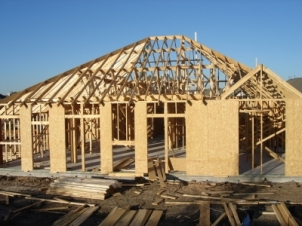
Employment Rise Fueled by Construction Jobs
By Stevie Duffin Updated on 4/5/2013By Daniel Duffield
Despite the shortfall of national employment that disappointed many in March, residential construction has seen a substantial improvement, the Department of Labor indicated.
According to Paul Ashworth, chief economist at Capital Economics, the statistics have not come as a surprise, considering the notable jump in homebuilding which has increased roughly tenfold during the past year. With such growth, employment has been affected, with construction assuming one of the most prominent sources of employment.
In March, the aggregate growth in national employment hit 1.4%, while employment for residential construction projects rose 3.8% over March 2012 figures.
In spite of sluggish construction action, the number of construction projects has consistently risen. In fact, the rate of construction employment per household for residential projects has grown above the pre-bubble figures at 3.7 jobs for each construction unit, compared with 2.6 in 2001.
Fannie Mae Chief Economist Doug Duncan stated that the delay in the reported figures began with statistics that indicated sluggish activity within the manufacturing and service industries this month.
Douncan continue to say that, despite this trend, the overall increase in construction jobs in March, which boosted the average monthly gains of the first quarter to a seven year peak of 30,000 jobs, reinforces the idea that the housing recovery effort will plow forward regardless of the minor inconveniences caused by such fiscal setbacks. As such, this trend would be consistent with the effects witnessed from the March National Housing Survey, which is slated to be released this coming Monday.
Jed Kolko, chief economist at Trulia, points out that with the growth of the economic recovery, home builders will be increasingly likely to undergo labor shortages as construction surges past employment levels.
In a blog post on Trulia, Kolka indicated that the ratio of jobs to activity is still currently situated 26% higher than before the burst of the housing bubble, during which time the dollar value was employed including remodeling, rather than the units as measuring the amount of activity.
However, not all metros have followed suit, with some areas being subject to construction gains that are outpaced by the amount of construction activity. Such markets include San Francisco, San Jose, Washington D.C., Denver, Seattle, Orange County, and San Diego.
Kolko states that the housing market recovery has gained strength, with the growth in construction jobs and action. However, he anticipates that the amount of jobs per construction unit will decline, rather than increase, while leveling off to figures near those seen before the housing bubble.
In order for the number of jobs in relation to construction projects to stabilize to acceptable levels, construction activity will need to grow at a faster rate than construction jobs.
According to Kolko, “For builders who are reporting labor shortages today, that headache is likely to get worse, not better, as the recovery continues.”

Didn't find the answer you wanted? Ask one of your own.
-
 What You Need To Know About Escrow
View More
What You Need To Know About Escrow
View More
-
 President Obama Initiates Lower FHA Mortgage Insurance Premiums
View More
President Obama Initiates Lower FHA Mortgage Insurance Premiums
View More
-
 What is Quantitative Easing?
View More
What is Quantitative Easing?
View More
-
 The 5 New Mortgage and Housing Trends for Summer 2013
View More
The 5 New Mortgage and Housing Trends for Summer 2013
View More
-
 Fannie Mae profitability skyrockets
View More
Fannie Mae profitability skyrockets
View More
-
 Foreclosure protections for more soldiers after lawmakers draft bill
View More
Foreclosure protections for more soldiers after lawmakers draft bill
View More
-
 FHFA: HARP success follows low mortgage rates, February refinance volume strong
View More
FHFA: HARP success follows low mortgage rates, February refinance volume strong
View More
-
 Use of Mortgage Interest Deduction Depends on Where You Live
View More
Use of Mortgage Interest Deduction Depends on Where You Live
View More
-
 HUD will sell 40,000 distressed loans in 2013
View More
HUD will sell 40,000 distressed loans in 2013
View More
-
 Mortgage Principal Reduction Could Save Taxpayers $2.8 Billion
View More
Mortgage Principal Reduction Could Save Taxpayers $2.8 Billion
View More
-
 Mortgage Applications Regain Traction after Sluggishness, Rates Continue to Fall
View More
Mortgage Applications Regain Traction after Sluggishness, Rates Continue to Fall
View More
-
 HARP 3.0 Discussions Reveal Little Hope for HARP Update
View More
HARP 3.0 Discussions Reveal Little Hope for HARP Update
View More
-
 Home Prices Rise in February According to LPS Data
View More
Home Prices Rise in February According to LPS Data
View More
-
 Balancing Act: House Committee Hears Opposing Viewpoints Over Mortgage Interest Rate Deduction
View More
Balancing Act: House Committee Hears Opposing Viewpoints Over Mortgage Interest Rate Deduction
View More
-
 Near Record Low Mortgage Rates Buoy Housing Recovery
View More
Near Record Low Mortgage Rates Buoy Housing Recovery
View More
Related Articles
Ask our community a question.
Searching Today's Rates...

Featured Lenders
Lisa Stepp
RBS Citizens
Clifton Park, NY

